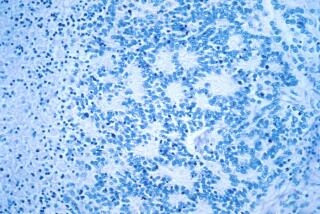Patients Show Decreased Symptoms : New Treatment Technique Slows Some Leukemias
- Share via
SAN DIEGO — An experimental technique that uses a light-activated drug to kill cancer cells in blood removed temporarily from certain leukemia patients may prove useful in treating some blood cancers and diseases such as arthritis and lupus, a researcher says.
When the treated blood was placed back into the bodies of two patients with the rare, extreme form of one type of leukemia, or blood cancer, it appeared to stimulate their bodies’ immune systems to slow the uncontrolled, cancerous production of white blood cells.
But the technique has only limited potential for halting some leukemias, and is really aimed at treating symptoms of those cancers and of so-called auto-immune diseases, including myasthenia gravis, lupus and arthritis, said Dr. Richard M. Edelson of New York’s Columbia-Presbyterian Medical Center.
Attacks Abnormal Cells
It might eventually be used to sharply reduce the symptoms of those diseases by killing abnormal white blood cells after they are produced, he explained.
Edelson outlined the technique recently at the American Cancer Society’s science writers seminar.
He used the method on 11 patients with the leukemia version of a cancer called cutaneous T-cell lymphoma, in which malignant T lymphocytes--a type of white blood cell--invade the lymph nodes and skin and circulate in the blood.
The patients were given a form of the drug psoralen, which occurs naturally in some fruits and vegetables but by itself has no known effect. Each patient’s blood was then removed through an arm vein, routed through a clear plastic tube--where it was exposed to mild ultraviolet light--then placed back into the patient through another arm vein.
The ultraviolet light activated the drug so it killed the cancerous white blood cells in the blood. Then the drug reverted to its inactive form as it re-entered the body. Three patients didn’t improve, but eight of the 11 patients had decreased symptoms.
Two of the eight showed sharply reduced cancer cell production even after treatment stopped, suggesting the method somehow stimulated their immune system to combat the leukemia.
Because this “photochemotherapy” technique killed the cancerous cells outside the body, it avoids the harmful side effects of conventional chemotherapy, which damages or kills cells throughout the body, not just cancerous ones, Edelson said.
Costly Alternative
While conventional chemotherapy drugs also might be used to treat blood removed from the body, the toxic drugs would have to be filtered from the blood before it was replaced--a costly and complex step unneeded with the light-activated drug, he said.
Arthritis and other auto-immune diseases occur when the body’s disease-fighting immune system attacks the body itself by overproducing other types of white blood cells. So photochemotherapy might be used to kill or damage those cells to reduce the symptoms of such diseases, Edelson said.
“The ultimate use of this therapy in any particular disease is an open game,” he said. “Right now, we’re at an extremely early stage.”
In arthritis, abnormal white blood cells attack the joints. In lupus, they attack the kidneys, skin, nerves and joints. And in myasthenia gravis, they attack muscle.
Edelson doubted the method would work against acute, childhood leukemia because cancerous white blood cells proliferate very rapidly in that disease. But he said it might be used to kill the circulating cancer cells while conventional chemotherapy is used to halt their production.
He said experimental use of photochemotherapy against arthritis and other auto-immune diseases must await government approval. But it will be tried against the cutaneous T-cell lymphoma type of leukemia in clinical trials just getting started at Columbia and five other medical centers.
Edelson said he is trying to develop another light-activated drug that could be targeted only at the types of white blood cells that grow abnormally in any given auto-immune disease, thereby avoiding damage to other, disease-fighting white blood cells.






